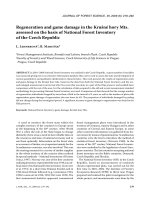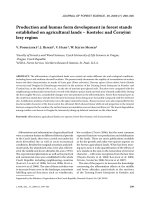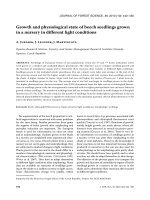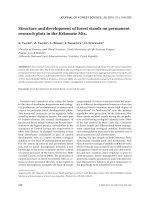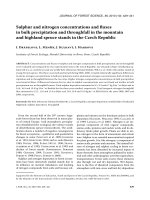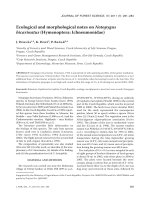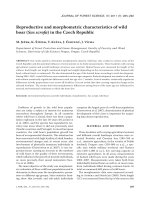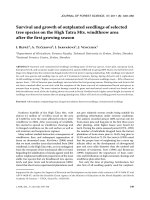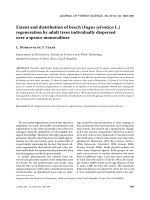Báo cáo lâm nghiệp: "Morphological and functional variability in the root system of Quercus ilex L. subject to confinement: consequences for afforestation" ppt
Bạn đang xem bản rút gọn của tài liệu. Xem và tải ngay bản đầy đủ của tài liệu tại đây (186.28 KB, 6 trang )
Ann. For. Sci. 63 (2006) 425–430 425
c
INRA, EDP Sciences, 2006
DOI: 10.1051/forest:2006022
Original article
Morphological and functional variability in the root system of
Quercus ilex L. subject to confinement: consequences for afforestation
Jesús P
´
a
, Jordi V
a
, Eustaquio G-P
b
*
a
Departament de Producció Vegetal i Ciència Forestal, Universitat de Lleida, Av. Alcalde Rovira Roure 191, 25198, Lleida, Spain
b
Unit of Forests Resources, CITA de Aragón, Avda. Montañana 930, 50059, Zaragoza, Spain
(Received 21 June 2005; accepted 3 October 2005)
Abstract – We examined root morphological and functional differences caused by restrictions imposed to vertical growth in the root system of holm
oak (Quercus ilex L.) seedlings to assess the consequences of using nursery containers in the development of a confined root system for this species.
Thus, root morphological, topological and functional parameters, including hydraulic conductance per leaf unit surface area (K
RL
), were investigated in
one-year seedlings cultivated in three PVC tubes differing in length (20, 60 and 100 cm). Longer tubes showed greater projected root area, root volume,
total and fine root lengths, specific root length (SRL) and K
RL
values than did shorter tubes. On the other hand, the length of coarse roots (diameter
> 4.5 mm) and the average root diameter were greater in shorter tubes. The strong positive correlation found between K
RL
and SRL (r =+0.69;
P < 0.001) indicated that root thickness was inversely related to water flow through the root system. We concluded that root systems developed in
longer tubes are more efficient for plant water uptake and, therefore, changes in root pattern produced in standard forest containers (i.e. about 20 cm
length) may in fact prevent a proper establishment of the holm oak in the field, particularly in xeric environments.
Quercus ilex L. / root hydraulic conductance / root morphology / afforestation
Résumé – Variabilité morphologique et fontionnelle du système racinaire de Quercus ilex L. soumis au confinement : conséquences pour les
reboisements. Nous avons examiné les différences morphologiques et fonctionnelles qui ont été induites par des restrictions imposées au développe-
ment vertical des racines de plantules de chêne (Quercus ilex L.). Les paramètres morphologiques, topologiques et fonctionnels du système racinaire, et
aussi la conductivité hydraulique par unité de surface foliaire (K
RL
), ont été recherchés sur des plantules d’une année cultivées dans des tubes de PVC
de différentes longueurs (20, 60 et 100 cm). Les tubes les plus longs présentent des surfaces projetées de racines, des volumes racinaires, des longueurs
de racines fines et totales, des longueurs spécifiques SRL et des K
RL
supérieurs à ceux des tubes courts. Inversement, dans les tubes courts se trouvent
des racines de plus fortes sections avec les longueurs les plus grandes de grosses racines (diamètre > 4,5 mm). La forte corrélation positive trouvée
entre K
RL
et SRL (r =+0, 69 ; P < 0, 001) a indiqué que la grosseur de la racine est inversement proportionnelle au flux d’eau transporté. On conclut
que les systèmes racinaires développés dans des tubes plus longs sont plus efficaces dans l’extraction de l’eau et, par conséquence, les modifications
dans le modèle du développement des racines qui ont été produites dans les conteneurs standards (e.g. environ 20 cm de longueur) pouvaient empêcher
l’établissement approprié du chêne in situ, surtout dans des environnements à fortes contraintes hydriques.
Quercus ilex L. / conductance hydraulique racinaire / morphologie racinaire / reboisements
1. INTRODUCTION
About one million hectares of agricultural land were af-
forested in the European Union from 1994 to 1999. The holm
oak (Quercus ilex L.) was the most extensively used species
[22] mainly due to its wide ecological amplitude. Indiffer-
ent to lithological substratum, the holm oak is found in the
thermo, meso and upper Mediterranean thermotypes and in
semiarid, dry and humid climates [27]. It stands among the
deepest-rooted plant species [10], developing a strong taproot
that usually grows several centimetres in length within a few
weeks of germination. By the end of the first growing season,
the taproot can easily reach a length of 50 cm or even one
meter [11, 24]. This feature allows for deep water uptake dur-
ing drought episodes [12, 13]. The taproot in the holm oak is
highly orthogeotropic, though this characteristic may not be
* Corresponding author:
present in mesic environments [3], and several zones can be
distinguished showing unequal development of lateral roots
[3, 24]. In semiarid climates, such a differential development
may have important consequences for the dynamics of water
extraction during a soil-drying cycle, as described for Quercus
coccifera [23].
In afforestation programmes, the holm oak is established
either through seeding or planting (traditionally, both meth-
ods have been recommended), provided that acorn predators
are controlled [11, 15]. Although similar experimental re-
sults have been obtained with regard to survival [1, 4, 9],
shoot growth patterns clearly differ for both methods. Indeed,
one-year seedlings often discontinue their shoot elongation
shortly after transplanting, especially under drought or com-
petition. At this time, a new taproot and fine lateral roots are
formed (Pemán and Gil, unpublished results). This observa-
tion suggests that the seeding and planting techniques may
Article published by EDP Sciences and available at or />426 J. Pemán et al.
bear different consequences with regard to root system devel-
opment, which may ultimately affect seedling establishment
[34].
When container seedlings are used for planting, the con-
tainer characteristics affect the plantlet root system. For ex-
ample, ribs or slits on the cell inner walls prevent root spi-
ralling, and holes in the base facilitate drainage and encourage
air pruning of roots. Continual air pruning induces a limita-
tion to the main root growth by shortening its length to the
depth of the container and preventing the development of re-
placement taproots. The confining of lateral roots in the con-
tainer and their downward growth lead to the generation of an
orthogeotropic lateral root system rather than the more usual
plagiotropic one that originates from the taproot air pruning
[24].
Fitter has proposed topological models for characteris-
ing root systems [6]. In particular, the herringbone and di-
chotomous structures are extreme cases of a wide range of
topologies. The herringbone system appears when branching
is confined to the main axis, hence resulting in the most or-
dered possible root pattern. The dichotomous structure devel-
ops when branching is equiprobable at all links. Theoretical
considerations suggest that herringbone-type root systems are
more efficient for resource acquisition, but more expensive to
produce and maintain because they support the greatest pro-
portion of high-magnitude links [6]. Simulation models con-
firm that the herringbone architecture would be favoured in
environments with low soil-resource availability [7, 8].
Roots impose the greatest resistance to liquid water flow in
the soil-plant-atmosphere continuum (SPAC) [26]. Thus, the
concept of root hydraulic conductance (K
R
) has been the sub-
ject of numerous studies. K
R
(i.e. the inverse of hydraulic re-
sistance) is defined as the ratio that measures water movement
through the roots relative to an external driving force control-
ling the water flow. The adequacy of the root system to supply
water to leaves can be estimated by the root hydraulic conduc-
tance per leaf unit surface area (K
RL
) [16]. According to the
composite transport model [32], root water supply to the shoot
may change according to the shoot demand owing to an adjust-
ment of root hydraulic conductance. Water deficit reduces root
growth and the capacity of roots to take up water by suberi-
sation [20, 26, 33]. Therefore, the root hydraulic conductance
may vary in response to external (drought or salinity) or in-
ternal (nutritional state, water status, demand of water) fac-
tors [32], but the extent by which changes in root morphology
influence root hydraulic conductance still needs to be deter-
mined.
The aim of this study was to describe and compare mor-
phology, topology and functional differences of root system
types developed within containers that vary in total length, as
an indirect approach to reproduce the holm oak root character-
istics generated under either the seeding or planting techniques
for afforestation. A better understanding of such differences
may thus be relevant for defining the most suitable afforesta-
tion method for this species in drought-prone Mediterranean
areas.
2. MATERIALS AND METHODS
The study used acorns from “La Mancha” (Spain) provenance re-
gion (altitude: 500–1 000 m; annual precipitation: 312–539 mm; cli-
mate: semiarid to subhumide). The acorns were cultivated in three
types of PVC tubes differing in length in order to evaluate differ-
ences in morphology and functional responses caused by restrictions
to growth in the holm oak root system. The shortest tube (ST) was
20 cm long, which is the recommended container length for holm oak
cultivation under Mediterranean conditions [9]. The largest tube (LT)
was 100 cm long, and was aimed at obtaining a root system devel-
oped without vertical restriction to growth. An intermediate length of
60 cm (hereafter, MT) was also used. A galvanized mesh was placed
at the bottom of the tubes to prevent substrate movement and to fa-
cilitate root air pruning. As container volume has a clear influence on
root system morphology [9, 21, 28], this parameter was kept nearly
constant by selecting the most appropriate tube diameter allowed by
the commercial offer: diameters chosen were 105 (ST), 59.5 (MT)
and 43 (LT) mm. This yielded volumes of 1 700 cm
3
(ST, MT) and
1 500 cm
3
(LT) respectively. The substrate employed was a mixture
of sand and silt (2:1 v/v) to facilitate root extraction and cleaning. A
slow-release fertiliser (OSMOCOTE
Mini 18+6+11) was incorpo-
rated into the bulk substrate in a dose of 3.5 g L
−1
. Forty seedlings
were cultivated in each container type according to a completely ran-
domized design and using one seed per container. Seedlings were
kept well watered during the growing period and were cultivated in
a shade house to tone down light intensity to 50% of the external so-
lar radiation. The study was carried out in the experimental fields of
CITA (Zaragoza, Spain) for one vegetative period in 1999.
2.1. Shoot morphology and root morphology
and topology
For the morphological characterisation of shoots and roots and the
topological characterisation of roots, 22 seedlings were taken ran-
domly per type of container at the end of the vegetative period (mid-
November). Plant height and root collar diameter were recorded for
each seedling using a Vernier calliper, and total leaf area (A
L
)was
estimated using an electronic planimeter (Delta-T, Cambridge, Eng-
land). Measurements were not performed on roots with a diameter
smaller than 0.5 mm. The following root variables were obtained
using the image analysis software WinRhizo
v.4.1 (Regent Ltd.,
Canada): projected root area (A
R
), total root length (L
R
), average
root diameter (D
R
), projected area relative to total length (A
R
/ L
R
),
root volume (V
R
), total length of roots with a diameter greater than
0.5 mm (L
R
), length by diametric classes (0.5 to 2 mm, L
R0.5<D≤2
;2to
4.5 mm, L
R2<D≤4.5
; > 4.5 mm, L
RD>4.5
), and the ratio of the length
for each dynamic class to the total length. Dry root weight (DRW)
was calculated after drying the roots in an oven at 60
◦
C for 48 h.
L
R
and DRW values were used to calculate the specific root length
index (L
R
/DRW) (hereafter SRL). This index is used as an indicator
of root thickness [26] and has been applied to study variations in root
morphology in relation to different nutrient levels, water content and
soil types [6].
Root topology was assessed by estimating the following param-
eters using the software WhinRhizo
v.4.1: number of exterior root
links (or magnitude, µ); number of root links in the longest unique
path from the base link to an exterior link (or altitude, a); and sum of
links in all possible unique paths from the base link to all exterior
links (or total exterior path length, p
e
). The following topological
Root system morphological and functional variability 427
indexes were then calculated: altitude-slope (the regression slope
of Log
10
a on Log
10
µ) and pathlength-slope (the regression slope of
Log
10
p
e
on Log
10
µ). High values of these indexes (with a theoreti-
cal maximum equal to one for the altitude-slope index) represent root
systems with a herringbone structure, in which branching is largely
confined to a main axis. Low values (with a theoretical minimum
equal to zero for both indexes) represent a dichotomous pattern, in
which all exterior links join another exterior link [6].
2.2. Root hydraulic conductance
At the end of the vegetative period, ten seedlings per tube type
were randomly taken. Root hydraulic conductance was estimated us-
ing a pressure chamber [5] adapted to the container size. In particular,
seedlings were cut at 80 mm above the substrate so that about 20 mm
of stem protruded from the pressure chamber [17]. Water flow (F)
was then measured on the stem cut-surface at different constant pres-
sures. Firstly, the chamber pressure was increased at a rate of 0.07
MPa min
−1
up to 0.7 MPa. After the first 10 min at 0.7 MPa, flow
was measured ten times (every two minutes) by placing Eppendorf
tubes filled with an absorbent sponge in contact with the stem cut
surface. The tubes were then weighed on a digital balance. After-
wards, the pressure was decreased at intervals of 0.175 MPa using a
rate of 0.07 MPa min
−1
, and flow measurements were repeated ten
times every two minutes at constant pressure levels of 0.525, 0.350
and 0.175 MPa. Water flow was approximately stable at any pressure
(coefficient of variation ≤ 7.5%) and, therefore, measurements were
quasi-steady state. Root hydraulic conductance (K
R
) was calculated
from the slope of the straight line relating water flow (F) to pres-
sure applied (P). In addition, the root hydraulic conductance per leaf
unit surface area (K
RL
) and the root hydraulic conductance per root
unit surface area (K
RR
) were obtained by dividing K
R
by A
L
and A
R
,
respectively.
2.3. Statistical analysis
In order to evaluate differences in root and shoot morphology be-
tween tube types, data on morphological variables were subjected to
analysis of variance (ANOVA) for a completely randomised design.
A discriminant canonical analysis was also performed to determine
which root variables showing significant differences in the ANOVA
were more effective to differentiate between root structures as af-
fected by tube type. An analysis of covariance was used to detect
differences between tube types for Log
10
a and Log
10
p
e
. In each case,
Log
10
µ was used as covariate, with container length being the factor
for analysis. Differences on Log
10
a and Log
10
p
e
were tested by the
interaction between the factor and Log
10
µ. The degree of correlation
between K
RL
and the root morphological variables was calculated us-
ing Pearson’s correlation coefficients. All analyses were performed
using standard SAS/STAT procedures [29].
3. RESULTS
There were no significant differences in shoot morphologi-
cal variables between tube types. As regards root morphology,
significant differences were found in D
R
,A
R
,V
R
,andDRW
(Tab. I), and in root length parameters (Tab. II). Particularly,
Figure 1. Discriminant canonical analysis for root morphological
variables. S: 20 cm depth tube (ST); M: 60 cm depth tube (MT); L:
100 cm depth tube (LT). Abbreviations are indicated in Tables II and
III (n = 22).
A
R
and V
R
were about 38% and 88% higher, respectively, in
LT than in ST, whereas D
R
was about 50% higher in ST than
in LT and DRW was about 50% higher in LT and ST than in
MT. Besides, L
R
was about two-fold higher in LT than in ST
(Tab. II). A similar trend was observed for L
R0.5<D≤2
.How-
ever, seedlings grown in ST showed a greater length of coarse
roots (L
RD>4.5
) than in LT and MT, which displayed similar
L
RD>4.5
values. In particular, L
RD>4.5
was around two-fold
higher in ST than in LT (Tab. II). On the other hand, the root
length of the intermediate diametric class (L
R2<D≤4.5
)showed
no significant variation between tube types. For ST, about 88%
of total root length corresponded to L
R0.5<D≤2
, whereas 5%
was related to L
RD>4.5.
For LT, values were 94% and 1% for
L
R0.5<D≤2
and L
RD>4.5
, respectively. Significant differences
between tube types were also detected for SRL, with LT hav-
ing around two-fold higher values than ST (Tab. II). There
were no significant differences in topological indexes between
tube types. Average values for altitude-slope and pathlength-
slope were 0.58 and 1.25, respectively.
A discriminant canonical analysis was performed in order
to obtain an overall differentiation between tube types given
measurements on root morphological variables (Fig. 1). The
first two canonical variables contributed to differentiate among
tube types, although the grouping of individual seedlings cor-
responding to each tube type was mainly observed along the
first canonical axis, which accounted for 86% of the total
between-group variance. According to the eigenvector posi-
tions, the most informative variables were L
RD>4.5
and V
R
,
together with other root characteristics such as L
R
and A
R
.
However, V
R
and the root length variables provided some-
what redundant information according to their partially over-
lapping position in the biplot, with overall higher values for all
these variables characterising the shorter (ST) tube type. On
the other hand, the information given by A
R
was less related
to that provided by the aforementioned traits.
428 J. Pemán et al.
Table I. Root morphology. Projected area, volume, dry root weight average diameter and DSW/DRW ratio.
Tube Projected area (A
R
)(cm
2
) Volume (V
R
)(cm
3
) Dry root weight (DRW) (g) Average diameter (D
R
)(cm) DSW/DRW
ST 36.8 b 1.1 b 1.2 a 0.20 a 1.4
MT 37.4 b 1.5 ab 0.8 b 0.15 b 1.1
LT 50.9 a 2.0 a 1.2 a 0.13 b 0.9
SE 3.87 0.16 0.09 0.006 0.19
SE: mean standard error. Different letters denote significant differences (p < 0.05), Tukey Test.
Table II. Root length. Total length of roots with diameter greater than 0.5 mm (L
R
), length of diametric class (0.5 < d ≤ 2 mm) (L
R0.5<D≤2
),
length of diametric class (2 < d ≤ 4.5 mm) (L
R2<D≤4.5
), length of diametric class (d > 4.5 mm) (L
RD>4.5
), specific root length (SRL), L
R0.5<D≤2
to L
R
ratioand L
RD>4.5
to L
R
ratio.
Tube L
R
(cm) L
R0.5<D≤2
(cm) L
R2<D≤4.5
(cm) L
RD>4.5
(cm) SRL (m g
−1
)L
R0.5<D≤2
/L
R
L
RD>4.5
/L
R
ST 191.5 b 169.1 b 13.4 9.0 a 1.92 b 0.86 b 0.05 a
MT 252.5 b 229.8 b 18.3 4.3 b 2.85 ab 0.90 a 0.02 b
LT 388.7 a 365.2 a 19.2 4.3 b 3.47 a 0.93 a 0.01 b
SE 28.10 26.73 2.07 0.69 0. 274 0.011 0.004
SE: mean standard error. Different letters denote significant differences (p < 0.05), Tukey Test.
Figure 2. Water flow through the root system for different pressures
applied in roots from different container types: 20 cm depth (circle),
60 cm depth (triangle) and 100 cm depth (square) (n = 10).
The relationship between flow measured (F) and pressure
applied (P) (Fig. 2) was linear for each pressure interval be-
tween 0.17 and 0.7 MPa (R
2
= 0.99), irrespective of con-
tainer type. The slope of the linear regression of F to P was
significantly smaller in ST than in LT and MT, indicating
that lower flows were obtained in ST for a particular pressure
value. K
RL
and K
RR
(Fig. 3) had significantly lower values
in ST as compared with LT and MT. In particular, K
RL
was
about three-fold higher in LT than in ST (3.19 × 10
−6
versus
1.18 × 10
−6
kg s
−1
m
−2
MPa
−1
). Differences in K
RL
between
LT and MT were not significant. Overall, K
RR
and K
RL
took
similar values for a particular tube type due to the similarity
between leaf surface and root surface areas. The correlation
analysis showed negative association between K
RL
and D
R
Figure 3. Root hydraulic conductance per leaf unit surface area (K
RL
,
empty columns), and per root unit surface area (K
RR
, solid columns)
for different container types. Average values accompanied by their
standard error. Different letters denote significant differences (p <
0.05), Tukey Test (n = 10).
(r = −0.55; P < 0.05), and positive relationships between
K
RL
and SRL (r =+0.69; P < 0.001),V
R
(r =+0.47; P <
0.05), L
R0.5<D≤2
(r =+0.49; P < 0.05) and L
R
(r =+0.47;
P < 0.05).
4. DISCUSSION
Although variation in tube length among container types
was considerable, it did not modify significantly shoot mor-
phology of one-year holm oak seedlings. This observation can
be attributed to the comparable total volume of all tube types
Root system morphological and functional variability 429
employed, since seedling size has been directly related to con-
tainer volume in many studies [2, 21, 28]. On the contrary, our
results indicate the development of different root morpholo-
gies owing to the influence of tube length. Overall, the deepest
tube showed the highest values of root length parameters, ex-
cept for L
RD>4.5
. In this case, higher L
RD>4.5
and D
R
values
for ST than for LT, probably caused by a more intense root
pruning in the former, are consistent with results described by
Riedacker and Belgrand for Quercus robur [25]. Those authors
found that lateral roots became thicker when vertical down-
ward growth of taproots was physically restrained. Since SRL
is often used either as an overall index of root thickness or
as an estimator of the benefit (length) to cost (dry weight) ra-
tio of the root system [26], the root pattern generated in LT
containers could be considered as more efficient than that ob-
tained in ST. The discriminant canonical analysis on morpho-
logical variables, on the other hand, succeeded in differentiat-
ing among groups of root morphologies belonging to each tube
type. In this regard, the root system generated by ST could be
distinguished from that of LT mainly through the gradient of
the first canonical function, in which the variables L
RD>4.5
and
A
R
provided rather complementary information.
Notably, the average value across tube types (0.58) obtained
for the slope of the regression line between the parameters al-
titude (a) and magnitude (µ) shows that the different root sys-
tems can be classified as being of the herringbone-type, the
most efficient structure for exploring and exploiting soil re-
sources [7]. On the other hand, the impossibility of differenti-
ating between root systems produced by different containers,
according to the topological models of Fitter [6], is notewor-
thy. In particular, the root system obtained in ST could not be
ascribed to a dichotomous model, as initially expected. This
finding suggests that the root system produced by a standard
container would not bear any of the associated structural ad-
vantages of such a root model (e.g., lower cost and greater
efficiency in water conduction as compared to the herringbone
model) [7, 8].
The relation between water flow and pressure applied was
linear, irrespective of tube type, as also reported by other au-
thors both for the holm oak and other species [17–19, 26].
For ST, K
RL
values were extremely low; on the contrary, K
RL
values for LT were high, in agreement with those reported in
other studies for this species [16, 17, 19]. Such differences be-
tween tube types suggest a greater efficiency in water uptake
from roots to leaves in LT and MT than in ST. Seasonal K
RL
changes reported by Nardini [17] for holm oak indicates that
this species presents a maximum efficiency in water uptake
during the spring, when the soil is still wet. Therefore, low K
RL
seedlings, such as those produced in standard containers, may
have their establishment compromised shortly after planting
under the harsh summer conditions typical of semiarid areas.
The strong positive correlation between K
RL
and SRL indi-
cates that the root systems characterised by less massive roots
per unit length have a higher hydraulic conductance [20, 26,
31]. Thus, our results would be in agreement with the view
that hydraulic architecture follows the ‘energy minimization’
principle introduced by the West et al. model (WBE) [14, 35],
since the root system developed in LT shows the lowest root
hydraulic resistance for a given investment (DRW).
According to the composite transport model [32], the radial
resistance to water flow was higher in the ST root system as
compared to the LT system, probably due to a higher suberi-
sation rate [26, 32, 33]. However, further research would be
needed to confirm this point. In fact, a low permeability of
coarser roots, together with a limited root-to-shoot ratio, is one
of the main causes of transplanting stress, which may affect
seedling establishment in field conditions [30].
In summary, our results reveal that there are morphological
and functional differences among root systems developed in
containers of different length. Particularly, root systems devel-
oped in larger tube types were more efficient in water uptake.
This outcome suggests that the modification of root growth
pattern brought about by commercial forest containers may
influence holm oak establishment in the field. Therefore, the
use of direct seeding, which allows for a non-restricted devel-
opment of the root system, may be the recommended choice
in afforestation programmes for the holm oak, particularly in
xeric environments where the incidence of recurrent drought
episodes compromises growth and survival.
Acknowledgements: The authors are grateful to E. Martin and N.
Ibarra for technical assistance. This research was partially supported
by the CICYT research project AGL2003-01472, Spain.
REFERENCES
[1] Bocio I., Navarro F.B., Ripoll M.A., Jiménez M.N., De Simón E.,
Holm oak (Quercus rotundifolia Lam.) and Aleppo pine (Pinus
halepensis Mill.) response to different soil preparation techniques
applied to forestation in abandoned farmland, Ann. For. Sci. 61
(2004) 171–178.
[2] Callaway R.M., Effects of soil water distribution on the lateral root
development of tree species of California oaks, Amer. J. Bot. 77
(1990) 1469–1475.
[3] Canadell J., Djema A., López B., Lloret F., Sabaté S., Siscart D.,
Gracia C., Structure and dynamics of the root systems, in: Rodá
F., Retana J., Gracia C., Bellot J. (Eds.), Ecology of Mediterranean
evergreen oak forests, Springer, Berlin, 1999, pp. 47–59.
[4] Carreras C., Sánchez J., Reche P., Herrero D., Navarro A., Navío
J., Siembras profundas con ayuda de tubos protectores, Resultados
de ensayos comparativos de siembras y plantaciones bajo condi-
ciones de aridez en Vélez-Rubio, in: Sociedad Española de Ciencias
Forestales (Ed.), II Congreso Forestal Español, Pamplona, Tomo III,
1997, pp. 123–128.
[5] Fiscus E.L., The interaction between osmotic- and pressure-induced
water flow in plant roots, Plant Physiol. 55 (1975) 917–922.
[6] Fitter A., Functional significance of root morphology and root sys-
tem architecture, in: Fitter A., Atkinson D., Read D.J., Usher M.B.
(Eds.), Ecological interactions in soil, Blackwell, Oxford, 1985,
pp. 87–106.
[7] Fitter A., Stickland T.R., Harvey M.L., Architectural analysis of
plant root systems. 1. Architectural correlates of exploitation effi-
ciency, New Phytol. 118 (1991) 375–382.
[8] Fitter A., Stickland T.R., Architectural analysis of plant root sys-
tems. 2. Influence of nutrient supply on architecture in contrasting
plant species, New Phytol. 118 (1991) 383–389.
[9] Iglesias A., Repoblaciones con Quercus ilex L. en zonas degradadas
de la provincia de Ávila. Técnicas para mejorar su supervivencia,
Tesis Doctoral, Universidad Politécnica de Madrid, 2004.
430 J. Pemán et al.
[10] Joffre R., Rambal S., Damesin C., Functional atributes in
Mediterranean-type Ecosystems, in: Puignaire F.I., Valladares F.
(Eds.), Handbook of functional plant ecology, Marcel Dekker, New
York, 1999, pp. 347–380.
[11] Johnson P.S., Shifley S.R., Rogers R., The ecology and silviculture
of oaks, CABI Publishing, New York, 2002.
[12] Kozlowski T., Kramer P.J., Pallardy S.G., The physiological ecol-
ogy of woody plants, Academic Press, San Diego, 1991.
[13] Levitt J., Responses of plants to environmental stresses, Vol. II,
Academic Press, New York, 1980.
[14] McCulloh K.A., Sperry J.S., Patterns in hydraulic architecture and
their implications for transport efficiency, Tree Physiol. 25 (2005)
257–267.
[15] Montoya J.M., Técnicas de reforestación con encinas, al-
cornoques y otras especies de Quercus mediterráneos, Ministerio
de Agricultura Pesca y Alimentación, Madrid, 1995.
[16] Nardini A., Ghirardelli L., Salleo S., Vulnerability to freeze stress
of seedling of Quercus ilex L.: an ecological interpretation, Ann.
Sci. For. 55 (1998) 553–565.
[17] Nardini A., Lo Gullo M.A., Salleo S., Seasonal changes of root hy-
draulic conductance (KRL) in four forest trees: an ecological inter-
pretation, Plant Ecol. 139 (1998) 81–90.
[18] Nardini A., Tyree M., Root and shoot hydraulic conductance of
seven Quercus species, Ann. For. Sci. 56 (1999) 371–377.
[19] Nardini A., Salleo S., Tyree M., Vertovec M., Influence of the ec-
tomycorrhizas formed by Tuber melanosporum Vitt. on hydraulic
conductance and water relations of Quercus ilex L. seedlings, Ann.
For. Sci. 57 (2000) 305–312.
[20] North G.B., Nobel P.S., Changes in hydraulic conductivity and
anatomy caused by drying and rewetting of roots of Agave deserti
(Agavaceae), Am. J. Bot. 78 (1992) 906–915.
[21] Paterson J., Growing environment and container type influence field
performance of black spruce container stock, New For. 13 (1997)
329–339.
[22] Picard O. (Coord.), Evaluation of the Community aid scheme
for forestry measures in agriculture of Regulation No. 2080/92,
Institute for Forestry Development, Auzeville, 2001.
[23] Rambal S., Water balance and pattern of root water uptake by a
Quer cus coccifera L. evergreen scrub, Oecologia 62 (1984) 18–25.
[24] Riedacker A., Deixheimer J., Tavakol R., Alaoui H., Modifications
expérimentales de la morphogenèse et des géotropismes dans le sys-
tème racinaire de jeunes chênes, Can. J. Bot. 60 (1982) 765–778.
[25] Riedacker A., Belgrand M., Morphogenèse des systèmes racinaires
des semis et boutures de chêne pédonculé, Plant soil 71 (1983) 131–
146.
[26] Rieger M., Litvin P., Root system hydraulic conductivity in species
with contrasting root anatomy, J. Exp. Bot. 50 (1999) 201–209.
[27] Rivas Martínez S., Memoria del Mapa de Series de Vegetación de
España, Ministerio de Agricultura Pesca y Alimentación, Madrid,
1987.
[28] Romero A., Ryder J., Fisher J., Mexal J.G., Root system modifica-
tion of container stock for arid land plantings, For. Ecol. Manage.
16 (1986) 281–290.
[29] SAS Institute, SAS/STAT User’s Guide, Version 8, SAS Institute,
Inc., Cary, N.C., 1999.
[30] South D., Zwolinski J.B., Transplant stress index: A proposed
method of quantifying planting check, New For. 13 (1997) 315-328.
[31] Steudle E., Meshcheryakov A.B., Hydraulic and osmotic properties
of oak roots, J. Exp. Bot. 47 296 (1996) 387–401.
[32] Steudle E., Water uptake by plant roots: an integration of views,
Plant soil 226 (2000) 45–56.
[33] Steudle E., Water uptake by roots: effects of water deficit, J. Exp.
Bot. 51 350 (2000) 1531–1542.
[34] Vilagrosa A., Estrategias de Resistencia al déficit hídrico en
Pistacia lentiscus L. y Quercus coccifera L. Implicaciones en la re-
población forestal, Tesis Doctoral, Universidad de Alicante, 2002.
[35] West G.B., Brown J.H., Enquist B.J., The origin of universal scal-
ing laws in biology, in: Brown J.H., West G.B. (Eds.), Scaling in
biology, Oxford University Press, Oxford, 2000, pp. 87–112.
To access this journal online:
www.edpsciences.org
